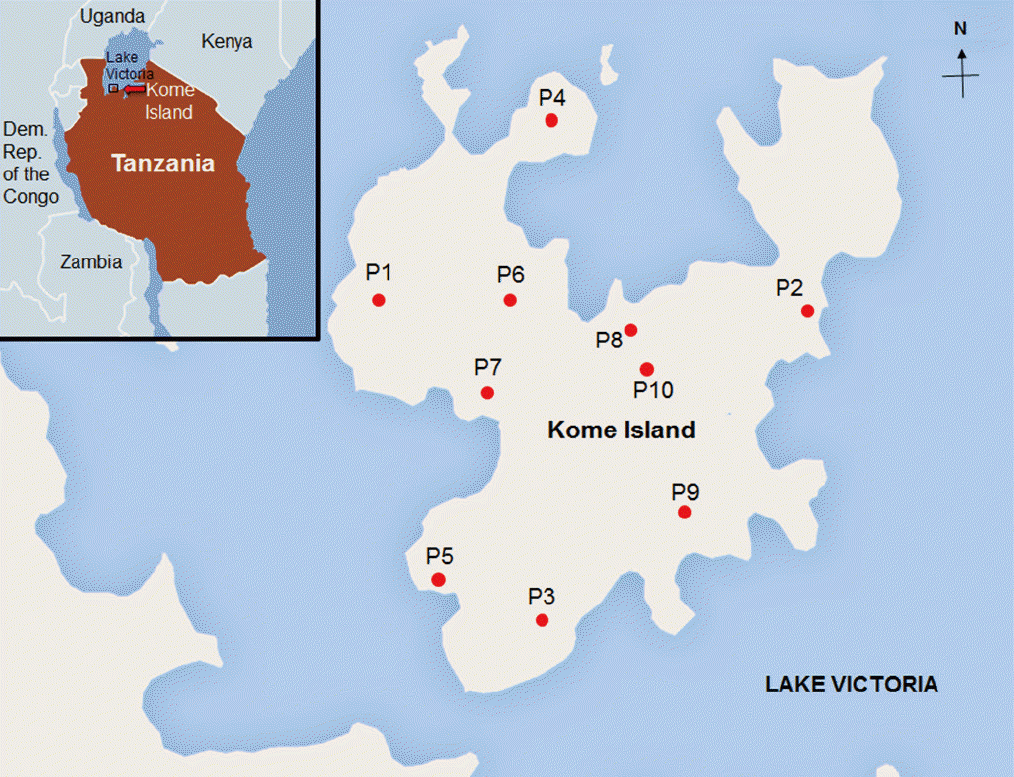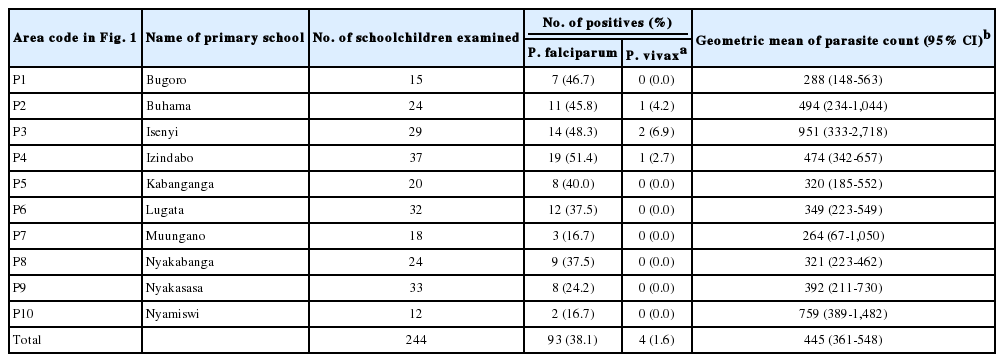High Malaria Prevalence among Schoolchildren on Kome Island, Tanzania
Article information
Abstract
In order to determine the status of malaria among schoolchildren on Kome Island (Lake Victoria), near Mwanza, Tanzania, a total of 244 schoolchildren in 10 primary schools were subjected to a blood survey using the fingerprick method. The subjected schoolchildren were 123 boys and 121 girls who were 6-8 years of age. Only 1 blood smear was prepared for each child. The overall prevalence of malaria was 38.1% (93 positives), and sex difference was not remarkable. However, the positive rate was the highest in Izindabo Primary School (51.4%) followed by Isenyi Primary School (48.3%) and Bugoro Primary School (46.7%). The lowest prevalence was found in Muungano Primary School (16.7%) and Nyamiswi Primary School (16.7%). These differences were highly correlated with the location of the school on the Island; those located in the peripheral area revealed higher prevalences while those located in the central area showed lower prevalences. Plasmodium falciparum was the predominant species (38.1%; 93/244), with a small proportion of them mixed-infected with Plasmodium vivax (1.6%; 4/244). The results revealed that malaria is highly prevalent among primary schoolchildren on Kome Island, Tanzania, and there is an urgent need to control malaria in this area.
Malaria is one of the major public health problems particularly in tropical and subtropical areas. Among the age groups, young children and pregnant women are the highest risk group [1]. Plasmodium falciparum is the most widespread and highly prevalent, which is followed by Plasmodium vivax and Plasmodium malariae. It was reported that 1.24 million deaths were caused by malaria in 2010, and among them 714,000 were children under 5 years of age [2]. With regard to the geographical locations, it is notable that more than 80% of the malaria deaths occurred in sub-Saharan Africa [2]. Tanzania is located at the mid-eastern part of sub-Saharan Africa south to Kenya and Uganda and north to Mozambique. In Tanzania, malaria prevalence was reported to be variable according to geographical regions and ecosystem [3-6]. In a national survey performed in 2011-2012 in Tanzania, high malaria prevalence was reported in regions adjacent to Lake Victoria (Geita; 20.7% and Mara; 14.4%) and Lake Tanganyika (Kigoma; 9.9%) [3]. However, further surveys are needed to determine the status of malaria around Lake Victoria, including the inlake islets and islands which are high risk areas. In the present study, a small cross-sectional survey was undertaken to determine the status of malaria by blood smear examinations among primary schoolchildren on Kome Island, Lake Victoria, Tanzania.
The study was carried out in 10 primary schools (Buhama, Bugoro, Isenyi, Izindabo, Kabaganga, Lugata, Nyakabanga, Nyakasasa, Nyamiswi, and Muungano) located on Kome Island, Sengerema District, Mwanza, Tanzania in June 2009 (Fig. 1). Kome Island is located in a southernmost part of Lake Victoria and has a total population of about 47,000. The location of the schools is scattered all over the island, either at peripheral areas or near the central part of the island (Fig. 1). The schoolchildren were screened for malaria parasites using microscopy of peripheral blood smears, 1 smear per person. The fingerprick method was applied to draw 1-2 drops of blood. Thick and thin blood smears were prepared and stained with Giemsa and examined by 2 expert parasitologists from National Institute of Medical Research at Mwanza, Tanzania. For positive samples, the Plasmodium species was determined, and parasitemia of P. falciparum was determined. The number of asexual parasites per 200 leukocytes were counted and converted to the number of parasites per µl blood assuming 8,000 leukocytes per µl blood. A 95% confidence interval of the parasitemia was calculated for each school and for total subjected (Table 1). Basic demographic data and results of the microscopic examination were analyzed using the SPSS version 18.0. The prevalence and quantitative values of malaria parasitemia were compared between schools. This study was approved by “An international cooperative project on schistosomiasis and other parasitic diseases control in Mwanza area, Tanzania (2008-2013)” between Good Neighbors International, Korea and Korea International Cooperation Agency (KOICA) from Korea and National Institute of Medical Research (NIMR) from Tanzania. Informed consent was obtained from the school guardians or teachers of each primary school.

Map showing the surveyed areas (small circles) on Kome Island, Lake Victoria, Sengerema District, Mwanza, Tanzania. The schoolchildren of 10 primary schools were subjected in this study. P1, Bugoro; P2, Buhama; P3, Isenyi; P4, Izindabo; P5, Kabanganga; P6, Lugata; P7, Muungano; P8, Nyakabanga; P9, Nyakasasa; P10, Nyamiswi Primary School.

Prevalence of malaria and the level of parasitemia among primary schoolchildren on Kome Island, Lake Victoria, Tanzania
A total of 244 schoolchildren (123 male and 121 female), aged 6-8 years, 15-37 in number in each primary school, were examined (Table 1). Of the 244 blood smears examined, 93 (38.1%) were positive for malaria parasites; the prevalence of P. falciparum was 38.1% (93/244) and that of P. vivax was 1.6% (4/244) (Table 1). All P. vivax cases were mixed-infected with P. falciparum, with the latter predominating. The prevalence was not different between boys and girls (data not shown). The prevalence was the highest in Izindabo Primary School (51.4%) followed by Isenyi (48.3%), Bugoro (46.7%), and Buhama Primary School (45.8%). The lowest prevalence was found in Muungano (16.7%) and Nyamiswi Primary School (16.7%). The geometric means of P. falciparum parasitemia were between 288 and 951 (overall average; 445) asexual parasites per µl blood for individual school. Isenyi Primary School revealed the highest mean parasitemia (951/µl) followed by Nyamiswi (759/µl), Buhama (494/µl), Izindabo (474/µl), and Nyakasasa Primary School (392/µl) (Table 1). The malaria prevalence in each primary school was highly correlated with the location of the school on the Island; those schools located in the peripheral parts revealed higher prevalences while those schools located in the central areas showed lower prevalences (Table 1).
The results of the present study demonstrated a markedly high malaria prevalence compared to other studies performed in different areas of Tanzania [3,4]. For example, a national survey undertaken in different parts of Tanzania reported the general malaria prevalence of less than 10% for most of the regions other than Lake Victoria regions (Mara and Geita) which showed significantly higher malaria prevalences [3]. In Kilosa district, central Tanzania, the malaria prevalence of schoolchildren was as low as 4.5% [4]. However, around the lakeside areas of Lake Victoria malaria prevalence has been reported to be quite high [5,6]. For example, in another side of Lake Victoria, Magu district, north-western Tanzania, a high malaria prevalence of 29.8% [5] to 44.9% [6] was reported among school and pre-schoolchildren. Our study demonstrated a high prevalence of P. falciparum malaria, with a few mixed-infection cases with P. vivax, among schoolchildren on Kome Island, within Victoria Lake regions of Tanzania. All these data on malaria around Lake Victoria, Tanzanian side, are similar to other reports from islands in the other side of Lake Victoria, Uganda side [7] which reported 46.4% malaria prevalence among the children age group of ≤15 years.
It is interesting to note that the malaria prevalence showed a remarkable variation according to the localities of the schools on the island. Whereas the central parts of the island revealed lower malaria prevalence, the peripheral areas showed higher malaria prevalence. This could be attributed to various reasons such as the differences in the frequency of mosquito-breeding sites, availability of insecticide-treated mosquito-net and indoor residual spray use, and other health seeking behaviors of the guardians [8-10]. Preventive and control measures including chemoprophylaxis, early active and passive case detection of patients, mosquito control, and personal protection should be implemented urgently in this area. Conclusively, the present study detected high malaria prevalence among primary schoolchildren on Kome Island, Tanzania and suggested strongly that there is an urgent need to combat with malaria (mostly falciparum malaria) in this area.
Acknowledgements
We are grateful to the staff of National Institute of Medical Research, Mwanza, Tanzania for their assistance in doing this survey. Village leaders of Kome Island and school teachers of the surveyed primary schools are also thanked for their help in performing this survey.
Notes
The authors declare that they have no conflict of interest related to this study.